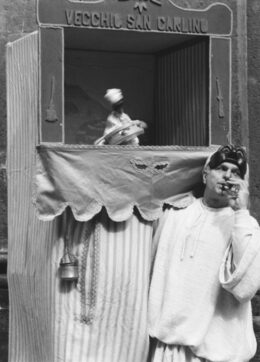Printed
16 pages
Author(s)
Storia di Carnevale
Il parto di Pulcinella
The Storia di Carnevale, Il parto di Pulcinella (Story of Carnival, Pulcinella giving birth) is one of the first shows written by Bruno Leone. Leone wrote this text between 1979 and 1985, during his formation with Nunzio Zampella, at the beginning of his career. For this play, he drew inspiration from the Pulcinella repertoire as well as from the traditions of the Neapolitan Carnival.
Nowadays, Leone often performs the last part of this play–Pulcinella birthing an egg–at the end of the performances of the traditional repertoire. This part is sometimes staged by other artists who believe it to be an ancient play, and who do not know that it is filed at the SIAE (Italian Society of Authors and Publishers) and copyrighted.
The protagonist gets rid of everyone who is opposed to his wedding
Pulcinella calls Teresina, his fiancée. He has already talked with her father and brother, and now wants to plan their wedding, but Teresina admits that they need to solve one last problem. Before falling in love with Pulcinella, Teresina was engaged to Vincenzo Carnevale, who does not know that their love story has ended. Pulcinella agrees to talk to him. First, Pulcinella and Carnevale argue, and fight for Teresina’s love. Then, Pucinella explains to Carnevale that Teresina does not want to marry him anymore. Carnevale pretends to accept this, but decides to sabotage Pulcinella’s wedding. He dresses up as a woman and seduces Pulcinella. As a woman, Carnevale is very attractive and also charms a guappo, Gennarino Cataclisma. When Gennarino realises that Carnevale is a man, he kills him before being murdered by Pulcinella. Pulcinella, Teresina, and the other puppets grieve Carnevale and sing the traditional dirges (nenie) that are dedicated to him in Naples.
In Hell, Carnevale meets Gennarino and the pair goes to honour their love. But first, Carnevale asks the devil Farfariello to sabotage Pulcinella and Teresina’s wedding. Farfariello asks his friend the rooster for help: he sends off his fiancée, the hen Cicerenella, to seduce Pulcinella. Pulcinella murders Cicerenella and makes a roast chicken out of her. The rooster seeks revenge. Farfariello curses Pulcinella: when he eats the chicken, he suffers from terrible abdominal pain. A doctor comes to help, misdiagnoses Pulcinella, and calls a midwife. Pulcinella gives birth to a large egg. As he is about to make an omelette with it, a little Pulcinella comes out of the egg, followed by four other Pulcinellini. Teresina, realising that Pulcinella birthed five children on his own, is overjoyed: she will not have to suffer. She is still determined to marry him. They both dance a final tarantella.
Publications and translations
Bruno Leone, La guarattella. Burattini e burattinai a Napoli. Bologna: CLUEB, 1986.
